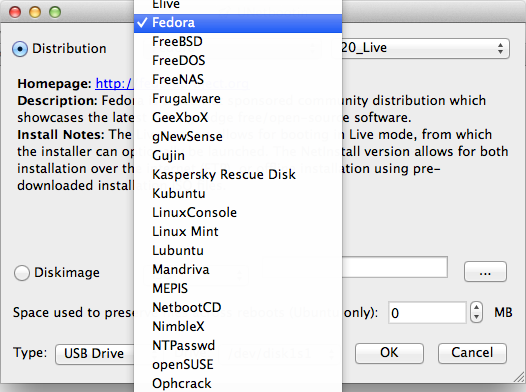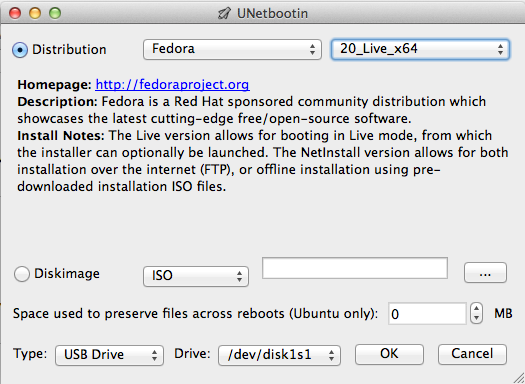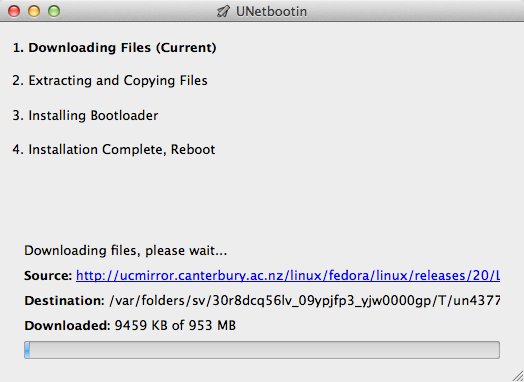
Posted on 10/29/2014 3:48:38 AM PDT by ShadowAce

Maybe you’ve heard about Linux and are intrigued by it. So intrigued that you want to give it a try. But you might not know where to begin.
You’ve probably done a bit of research online and have run across terms like dual booting and virtualization. Those terms might mean nothing to you, and you’re definitely not ready to sacrifice the operating system that you’re currently using to give Linux a try. So what can you do?
If you have a USB flash drive lying around, you can test drive Linux by creating a live USB. It’s a USB flash drive that contains an operating system that can start from the flash drive. It doesn’t take much technical ability to create one. Let’s take a look at how to do that and how to run Linux using a live USB.
Aside from a desktop or laptop computer, you’ll need:
A blank USB flash drive—preferably one that has a capacity of 4 GB or more.
An ISO image (an archive of the contents of a hard disk) of the Linux distribution that you want to try. More about this in a moment.
An application called Unetbootin, an open source tool, cross platform tool that creates a live USB. You don’t need to be running Linux to use it. In the instructions that below, I’m running Unetbootin on a MacBook.
Plug your flash drive into a USB port on your computer and then fire up Unetbootin. You’ll be asked for the password that you use to log into your computer.

Remember the ISO image that was mentioned a few moments ago? There are two ways you can get one: either by downloading it from the website of the Linux distribution that you want to try, or by having Unetbootin download it for you. To do that latter, click Select Distribution at the top of the window, choose the distribution that you want to download, and then click Select Version to select the version of the distribution that you want to try.

Or, you can download the distribution yourself. Usually, the Linux distributions that I want to try aren’t in the list. If you go the second route, click Disk image and then click the button to search for the .iso file that you downloaded.
Notice the Space used to preserve files across reboots (Ubuntu only) option? If you’re testing Ubuntu or one of its derivatives (like Lubuntu or Xubuntu), you can set aside a few megabytes of space on your flash drive to save files like web browser bookmarks or documents that you create. When you load Ubuntu from the flash drive again, you can reuse those files.

Once the ISO image is loaded, click OK. It takes anywhere from a couple of minutes to 10 minutes for Unetbootin to create the live USB.

This is the point where you have to embrace your inner geek a bit. Not too much, but you will be taking a peek into the innards of your computer by going into the BIOS. Your computer’s BIOS starts various bits of hardware and controls where the computer’s operating system starts, or boots, from.
The BIOS usually looks for the operating system in this order (or something like it): hard drive, then CD-ROM or DVD drive, and then an external drive. You’ll want to change that order so that the external drive (in this case, your live USB) is the one that the BIOS checks first.
To do that, restart your computer with the flash drive plugged into a USB port. When you see the message Press F2 to enter setup, do just that. On some computers, the key might be F10.
In the BIOS, use the right arrow key on your keyboard to navigate to the Boot menu. You’ll see a list of drives on your computer. Use the down arrow key on your keyboard to navigate to the item labeled USB HDD and then press F6 to move that item to the top of the list.
Once you’ve done that, press F10 to save the changes. You’ll be kicked out of the BIOS and your computer will start up. After a short amount of time, you’ll be presented with a menu listing the options for starting the Linux distribution you’re trying out. Select Run without installing (or the menu item closest to it).
Once the desktop loads, you can connect to a wireless or wired network, browse the web, and give the pre-installed software a whirl. You can also check to see if, for example, your printer or scanner works with the Linux distribution you’re testing. If you really, really want to you can also fiddle at the command line.
Depending on the Linux distribution you’re testing and the speed of the flash drive you’re using, the operating system might take longer to load and it might run a bit slower than it would if it was installed on your hard drive.
As well, you’ll only have the basic software that the Linux distribution packs out of the box. You generally get a web browser, a word processor, a text editor, a media player, an image viewer, and a set of utilities. That should be enough to give you a feel for what it’s like to use Linux.
If you decide that you like using Linux, you can install it from the flash drive by double clicking on the installer.

Apple interest?
You can also just make a bootable disk (CD or DVD) and run it off that.
It will be much slower on a USB drive or disk than an installed on HD version. But it lets you see if your hardware is compatible.
I can’t think of any reason to install Linux on a Mac. On a windows PC I use Cygwin for my daily work. The Mac has everything Linux has (more or less) already.
My wife’s laptop runs SLAX Linus on a 8 gig flash drive. It works great.
BTTT
Now the question is will Linux greet visitors from the NSA?
People trying this should also note that USB drives can vary greatly in speed.
http://www.tomshardware.com/reviews/usb-3.0-thumb-drive-review,3477.html
I’m rubbing Netrunner Linux on an older laptop and absolutely love it.
If you keep doing that your monitor will go dim.
How is a flash drive with no moving parts slower than a HDD that is spinning with a head that has to physically move across the sectors to read the data?
Bkmk for a future try at Linux...
USB works with Ubuntu, too.
As long as people realize the speed issue is due to the medium they are using, it should be a decent evaluation experience.
I might try this out but try to create a separate partition on my hard drive to do it. Hard drives are faster than USB aren’t they?
This article was trying to explain how to test it without making any lasting changes to your system--trying to remove any objections from that direction.
If you’ve got a rooted Android phone, you can skip using a flash drive altogether and use the DriveDroid app to try Linux.
DriveDroid comes with a catalog of Linux images that you can download straight to your phone. Once you have an image, you just tap it to select it from the DriveDroid main screen, choose to make your phone appear like a CD drive or USB drive, and then connect your phone to your computer.
Then, you just follow the same sort of BIOS boot selection that OP talks about.
Using a phone with DriveDroid will give you much better performance than a flash drive, and since it’s attached to your phone, which you probably carry at all times, it’ll always be available.
I would recommend anyone SSD to run your system. It is a flash -memory type drives with no moving parts typical to USB sticks and much faster than HDD on average.
I think installing OS on one of these is the most cost effective way to make your computer faster to date.
They are quite expensive for units larger than 256 GB to fully replace HDD technology by now, but sufficient to run system and demanding application already.
I saw an Apple Ibook G4 at the pawn shop for $99
I wonder how it would run with Linux?
Disclaimer: Opinions posted on Free Republic are those of the individual posters and do not necessarily represent the opinion of Free Republic or its management. All materials posted herein are protected by copyright law and the exemption for fair use of copyrighted works.